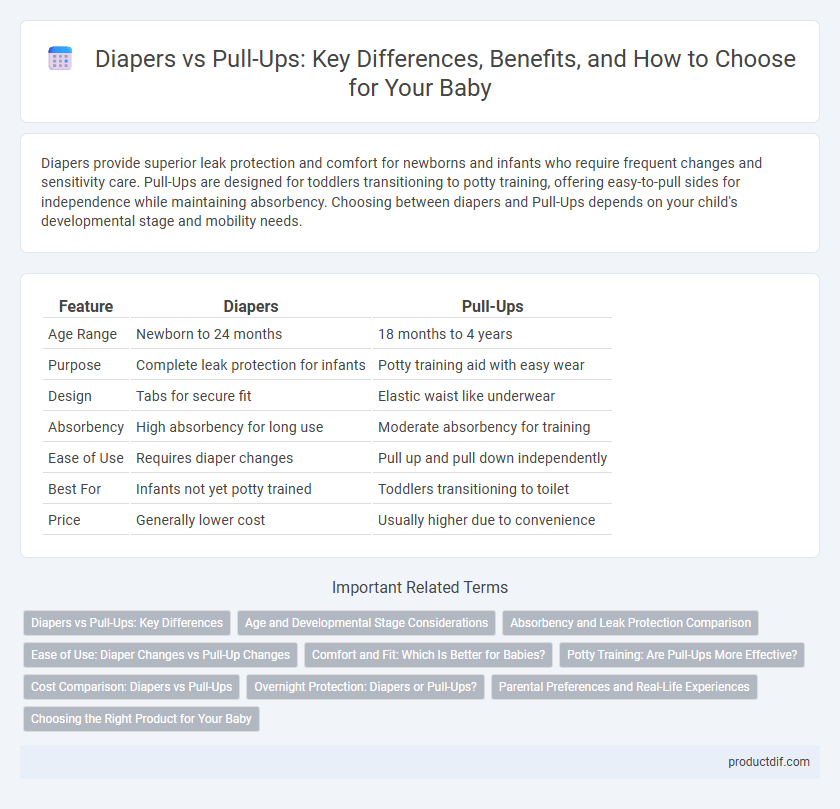Diapers provide superior leak protection and comfort for newborns and infants who require frequent changes and sensitivity care. Pull-Ups are designed for toddlers transitioning to potty training, offering easy-to-pull sides for independence while maintaining absorbency. Choosing between diapers and Pull-Ups depends on your child's developmental stage and mobility needs.
Table of Comparison
| Feature | Diapers | Pull-Ups |
|---|---|---|
| Age Range | Newborn to 24 months | 18 months to 4 years |
| Purpose | Complete leak protection for infants | Potty training aid with easy wear |
| Design | Tabs for secure fit | Elastic waist like underwear |
| Absorbency | High absorbency for long use | Moderate absorbency for training |
| Ease of Use | Requires diaper changes | Pull up and pull down independently |
| Best For | Infants not yet potty trained | Toddlers transitioning to toilet |
| Price | Generally lower cost | Usually higher due to convenience |
Diapers vs Pull-Ups: Key Differences
Diapers offer superior absorbency and leak protection, making them ideal for newborns and infants who require frequent changes. Pull-Ups provide a training pant style with easy pull-up and pull-down functionality, supporting toddlers in mastering potty training independence. The key differences lie in design, absorbency levels, and intended developmental stages, with diapers focusing on comfort and containment and pull-ups emphasizing convenience for potty training.
Age and Developmental Stage Considerations
Diapers are designed for infants and toddlers who are not yet potty trained, providing maximum absorbency and comfort for sensitive skin during naps and overnight. Pull-ups are designed for toddlers typically aged 2 to 4 years, promoting independence with easy-to-pull-on-and-off features that support potty training progress and encourage mobility. Selecting the right product depends on the child's developmental readiness, bladder control, and ability to communicate bathroom needs.
Absorbency and Leak Protection Comparison
Diapers offer superior absorbency and leak protection due to multiple layers of absorbent material that lock in moisture effectively, making them ideal for extended wear and overnight use. Pull-Ups provide moderate absorbency with flexible, training pant designs that prioritize ease of movement but may not prevent leaks as reliably during heavy wetting. Choosing between diapers and pull-ups depends on the child's developmental stage and activity level, balancing comfort with the need for leakage protection.
Ease of Use: Diaper Changes vs Pull-Up Changes
Diapers offer straightforward ease of use with quick tap closures and minimal fuss during changes, making them ideal for newborns and babies who need frequent diaper changes. Pull-Ups provide a more toddler-friendly design with elastic waistbands, allowing children to practice independence by easily pulling them up and down, which supports potty training stages. Both products prioritize convenience, but diapers excel in rapid, mess-free changes while pull-ups focus on fostering self-sufficiency.
Comfort and Fit: Which Is Better for Babies?
Diapers typically offer a snug fit with adjustable tabs, providing superior leak protection and comfort for newborns and infants. Pull-Ups feature stretchy sides and a more underwear-like design, promoting independence for toddlers while maintaining a comfortable fit during active movement. For babies prioritizing softness and secure fit, diapers often provide better comfort, whereas pull-ups suit toddlers transitioning to potty training.
Potty Training: Are Pull-Ups More Effective?
Pull-Ups offer a transitional solution that combines the absorbency of diapers with the independence needed for potty training, promoting confidence in toddlers. Research indicates toddlers using Pull-Ups tend to develop potty training habits faster due to the design that encourages self-removal and a greater sense of control. In contrast, traditional diapers, while highly absorbent, do not facilitate the learning process as effectively, potentially delaying potty training milestones.
Cost Comparison: Diapers vs Pull-Ups
Diapers generally cost less per unit than Pull-Ups, making them more economical for frequent changes and overnight use. Pull-Ups, designed for potty training, tend to be priced higher due to their training-friendly features like easy-to-pull sides and reusable designs. Families often choose diapers for cost-effective day-to-day use and switch to Pull-Ups during potty training despite the higher expense.
Overnight Protection: Diapers or Pull-Ups?
Overnight protection is crucial for ensuring a baby's comfort and skin health during extended sleep hours. Diapers typically offer superior absorbency and leak guards designed specifically for overnight use, reducing the risk of leaks and discomfort. Pull-ups provide convenience for toddlers transitioning to potty training but generally have less absorbency than overnight diapers, making diapers the preferred choice for effective overnight protection.
Parental Preferences and Real-Life Experiences
Parents often choose between diapers and Pull-Ups based on their child's comfort, ease of use, and potty training stage, with many favoring Pull-Ups for their resemblance to regular underwear during transition. Real-life experiences highlight that diapers provide superior leak protection for younger infants, while Pull-Ups encourage independence and confidence in toddlers learning to use the toilet. Parental reviews emphasize the importance of absorbency, fit, and skin sensitivity in determining the optimal option for daily use and nighttime needs.
Choosing the Right Product for Your Baby
Choosing the right product for your baby depends on their developmental stage and potty training readiness; diapers provide maximum absorbency for newborns and infants, while pull-ups are designed for toddlers transitioning to independent toileting with easy on-and-off features. Evaluating your baby's mobility, comfort needs, and skin sensitivity helps determine whether diapers or pull-ups offer the best fit and protection. Prioritizing breathable materials and hypoallergenic options enhances your baby's comfort and reduces the risk of irritation during this crucial growth phase.
Diapers vs Pull-Ups Infographic

 productdif.com
productdif.com